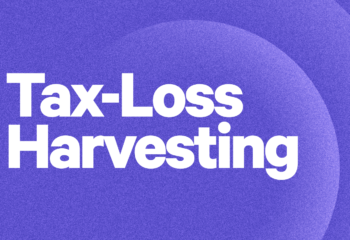At Wealthfront, we’re constantly looking for ways to make our products and services even better to help you build long-term wealth on your own terms. Today, we’re excited to announce an improvement to our investing product: we are updating three of the alternate ETFs Wealthfront uses to conduct Tax-Loss Harvesting.
We periodically review the ETFs we use to represent various asset classes to look for ETFs that have lower expense ratios, carry lower transaction costs because of higher liquidity, and more effectively track the desired index. We’re making these updates because we’ve identified ETFs we believe are a better fit. These improvements affect three asset classes in our expert-built portfolios: US Stocks, Municipal Bonds, and Dividend Growth Stocks. You don’t have to do anything to benefit from the changes: starting on December 20, we’ll begin purchasing the new alternate ETFs any time we previously would have purchased the old one. This change won’t cause you to incur any taxes — if you currently hold the old alternates, we will sell them to harvest losses only if the ETF trades below its purchase price.
In this post, we’ll explain exactly what’s changing and why.
New alternate ETF for Municipal Bonds
New ETF: iShares National Muni Bond ETF (MUB)
Old ETF: SPDR Nuveen Bloomberg Municipal Bond ETF (TFI)
Why we’re switching: MUB and TFI both provide investors with exposure to municipal bonds. However, we think MUB is better for three reasons.
One, MUB has a much lower expense ratio than TFI: MUB costs just 0.07% annually, whereas TFI costs 0.23%. Two, MUB is more liquid than TFI. Why does an ETF’s liquidity matter? An ETF’s liquidity tells you how easy it will be to sell your investment when you’re ready to cash out. An ETF with higher trading volume (ie, lots of people are buying and selling the ETF) is more liquid, and an ETF with lower trading volume is less so. Liquidity affects the cost of buying and selling an ETF because more liquid ETFs tend to trade with a smaller bid/ask spread (the difference between the top price someone will pay for an investment and the lowest price a seller will sell it for). If you’re comparing two ETFs that are otherwise identical, it’ll be cheaper to buy and sell the more liquid one. Combined, the lower expense ratio and better liquidity of the new ETF means Wealthfront clients will realize cost savings when they hold MUB instead of TFI.
The third reason we think MUB is better is the fact that it more closely tracks the Vanguard Tax-Exempt Bond Index Fund ETF (VTEB), which is the primary ETF we use for the Municipal Bonds portion of our Classic, Socially Responsible, and Direct Indexing portfolios. It’s important for an alternate ETF to be similar enough to its primary ETF in order to be sure that your portfolio accurately reflects your risk and return preferences over time as our software conducts Tax-Loss Harvesting on your behalf. Our research demonstrates that MUB is better suited to this task. Until recently, we could not use MUB as an alternate for VTEB because both tracked the same underlying index, so selling one and buying the other for Tax-Loss Harvesting could have constituted a wash sale. Wash sales aren’t illegal, but they do prevent you from using the loss against your taxable income that year. MUB recently switched to tracking a different underlying index, which made it possible to begin using MUB without triggering wash sales.
New alternate ETF for Dividend Growth Stocks
New ETF: iShares Core Dividend Growth ETF (DGRO)
Old ETF: Schwab US Dividend Equity ETF (SCHD)
Why we’re switching: DGRO and SCHD both focus on stocks with long histories of paying dividends to investors. But we believe DGRO offers a better after-tax, after-fee return for clients, and it’s also more closely correlated to the Vanguard Dividend Appreciation ETF (VIG), which is the primary ETF used to represent US Dividend Stocks in Wealthfront’s Classic and Direct Indexing portfolios.
Let’s unpack this a little. DGRO decides which stocks to include (and in what weights) based on a methodology that’s very similar to that used by VIG. SCHD, by contrast, has a slightly different methodology and a higher dividend yield as a result. To give you a sense for the scale of the difference, since July 2014, VIG has had yields of about 2%, DGRO’s has been about 2.3%, and SCHD’s has been closer to 3%. But dividend yield (or the percentage of the share price that gets paid out to investors annually) isn’t the whole story. Because dividends are taxed annually, SCHD actually has a higher annual tax cost, despite the fact that all three funds have had similar total returns. So even with DGRO’s slightly higher expense ratio (0.08% vs. 0.06% for SCHD), our research demonstrates that DGRO is superior in terms of after-tax, after-fee returns.
New alternate ETF for US Stocks
New ETF: iShares Core S&P Total US Stock Market ETF (ITOT)
Old ETF: Schwab US Broad Market ETF (SCHB)
Why we’re switching: ITOT and SCHB are very similar ETFs that track the broad US stock market, but with a key difference: ITOT is roughly twice as liquid as SCHB.
As a result, we think ITOT is a better alternate for the Vanguard Total Stock Market ETF (VTI), the primary ETF used to represent US Stocks in our Classic portfolio. Both ITOT and SCHB have an expense ratio of 0.03%, which means Wealthfront clients will realize a small cost savings from this update due to smaller trading costs associated with bid/ask spread.
Our products just keep getting better
At Wealthfront, our mission is to build a financial system that favors people, not institutions. In order to do that, we believe our products should improve continuously over time so our clients can benefit from our experts’ latest research. These changes to the alternate ETFs we use for Tax-Loss Harvesting are just one example of how we’re always looking for ways to make Wealthfront’s offerings even better.
Tax-Loss Harvesting is one of many ways Wealthfront uses software to help improve your after-tax returns, and we believe it’s among the most valuable features we offer. Tax-Loss Harvesting takes advantage of short-term fluctuations in the market to lower your tax bill with no extra effort and at no additional cost to you.
Disclosure
The information contained in this communication is provided for general informational purposes only, and should not be construed as investment or tax advice. Nothing in this communication should be construed as a solicitation, offer, or recommendation, to buy or sell any security. Any links provided to other server sites are offered as a matter of convenience and are not intended to imply that Wealthfront Advisers or its affiliates endorses, sponsors, promotes and/or is affiliated with the owners of or participants in those sites, or endorses any information contained on those sites, unless expressly stated otherwise.
Investment management and advisory services–which are not FDIC insured–are provided by Wealthfront Advisers LLC (“Wealthfront Advisers”), an SEC-registered investment adviser, and financial planning tools are provided by Wealthfront Software LLC (“Wealthfront”). Brokerage products and services are offered by Wealthfront Brokerage LLC, member FINRA / SIPC. All investing involves risk, including the possible loss of money you invest, and past performance does not guarantee future performance. Please see our Full Disclosure for important details.
Wealthfront Advisers, Wealthfront Brokerage and Wealthfront are wholly owned subsidiaries of Wealthfront Corporation.
© 2022 Wealthfront Corporation. All rights reserved.
About the author(s)
Alex Michalka, Ph.D, has led Wealthfront’s investment research team since 2019. Prior to Wealthfront, Alex held quantitative research positions at AQR Capital Management and The Climate Corporation. Alex holds a B.A. in Applied Mathematics from the University of California, Berkeley, and a Ph.D. in Operations Research from Columbia University. View all posts by Alex Michalka, Ph.D



